Here is the recording of a talk I gave recently. Do check it out!
Here’s a video of an introductory talk about Bharta Muni’s Natyashastra, the earliest Indian work about performing arts:
(This is the text of a speech I made this weekend at an event celebrating the composers from Karnataka. Throughout the article, the honorifics for all the composers and musicians are not mentioned. This is not to be treated as any mark of disrespect. A link to the speech is also provided at the end. I had to cut some parts while speaking because I was going over time! So the thought of sharing the complete script I made in preparation to the speech is posted here. Also, I have only mentioned a partial list of composers, due to the limitations on time, as well as my awareness)
Good afternoon rasikas.
It’s great feeling to be with the artists and the rasikas, celebrating the vaggeyakaras from Karnataka, here at the Livermore temple. I am sure you have all enjoyed the dance performances and are looking forward for the vocal and Veena performances. I am very pleased to share some of my observations with you all.
The term ‘vaggeyakara’ refers to someone who creates both the mAtu and dhatu, i.e. both the lyrical and musical content of a composition. It encompasses a larger meaning than the English word composer, which normally refers to the creation of the music part only. However, today I may use the word Vaggeyakara and composer somewhat interchangeably.
We can see indications of Indian classical music splitting into two streams by the 13th century.
The split probably started right after the time of Sharngadeva, who wrote his text Sangita Ratnakara. By the time of Pandarika Vithala, around 1600 CE, we can sense the split having been completed, making the two streams quite distinct and distinguishable from each other. The name Karnataka Sangeeta is a more recent entry though. One of the reasons that this stream was called Karnataka sangeeta seems to be the contribution of musicians,scholars and vaggeyakaras hailing from the Karnata samrajya or the Vijayanagara empire.
Throughout India’s history, there have been been different centers of music and culture. The contribution of musicians who hailed from current day Karnataka region is immense. The Vijayanagara kingdom, centered in current day Karnataka was a hub for arts and culture. Performing artists from various places made their way to Vijayanagara to get the royal support.
Sage Vidyaranya, who was instrumental in the establishment of the kingdom, was a musician himself and musicologist of merit. The first indications of classifications of Ragas in to melas (or groups) can be attributed to him. The latter day scholars and performers from Vijayanagara enhanced the textual framework of Vidyaranya. The Kalanidhi vyakhyana to Sangita Ratnakara by Kallinatha, the Swaramela Kalanidhi by his grandson Ramamatya give a good indication about the musical practices during the Vijayanagara times (14th to 16th century).
Music is a performance oriented art where shastra (i.e. theory) follows prayoga (or performance). New experiments happen all the time, and once they are accepted by rasikas, they get codified into texts and treatises. All these shastrakaras (i.e musicologists) could not have existed in vacuum. Those works became necessary to document what was going around them. While Indian classical music is manodharma or improvisation oriented, it is also true they need good compositions to anchor these improvisational ideas.
I wanted to clarify one thing — If the texts seem to come from royal patronage, it does not mean music was limited to royalty , but it only means that their patronage was necessary to write and preserve such works documenting the active music scene in the society of those times. The corpus of musical texts from the 15th/16th century Vijayanagara only confirms us that there was no dearth of performers or composers during this time, and it could not have been a limited royal engagement only.
Back in the 12th century, even before Vidyaranya, we have some indication that at least some vachans of shivasharanas of Karnatala were sung, from the internal evidence from vachanas of Akkamahadevi and Basavanna. But we absolutely have no idea about how they might have been sung. One or two centuries later, almost contemporary to Vidyaranya and Kallinatha, there were a host of Haridasas who revolutionized music as we know it. Unfortunately the original melodic structure of most Haridasa compositions is only known in their skeletal form, and the contemporary renditions of devaranamas are more modeled after much later compositions.
Haridasas introduced a lot of new types of compositions, including the Ugabhoga and Suladi.Starting off with Narahari tirtha, we later had Sripadaraya , Vyasaraya, Purandara dasa, Kanakadasa, Vijayadasa and a host of other haridasas who composed thousands of compositions from the 13th to the 19th century. Although we can’t say for sure, Sripadaraja was probably the first vaggeyakara who thought concepts like Ragamudre (raga signature), and sing a pada as a ragamalika. In a devarnama laali govinda laali, he has 3 charanas that indicate the rajamudra as devagandhara, ananda bhairavi and Kalyani.
The center of Karnataka sangeeta moved from Vijayananagara to Thanjavur after the fall of the empire. The beginning of the Thanjavur tradition can be traced back to Vijayanagara too. Thanjavur was given as a principality to Cevvappa Nayaka by Achyutaraya,the king of Vijayanagara. Ministers of The nayaks of Tanjavur such as Govinda dikshita and his son, the well known Venkatamakhi not only were able administrators but they were also expert musicians and musicologists.
We can easily say Venkatamakhi,who was also a Kannadiga, with his work Chaturdandi prakashika written around 1650 CE, sort of paved the way for new thinking in terms of the creation of new ragas in Karnataka sangeeta. In the 18th century, we know that haridasa compositions were very popular in Thanjavur. It’s well documented that Tyagaraja was very influenced by Purandara dasa’s devaranamas. Knowing that how the Karnataka Sangeeta trimurtis, Tyagaraja, Mudduswami Dikshita and Syama Shastry have influenced our music post 18th century, and the fact that the work of Venkatamakhi was instrumental in setting up them to do what they did with our music, tells a lot about the influence Venkatamakhi on Karnataka Sangeeta as we know it today.
With the taking over of Thanjavur by the British, the cultural hub again shifted to Mysuru. Now the Odeyars of Mysuru, similar to the Nayakas and Bhosales of Thanjavur, were not only patrons of music and arts, they were practitioners themselves. Mummadi Krishnaraja Odeyar himself was a compose of merit. Nalvadi Krishnaraja odeyar was trained in music too. And the last maharaja of mysore, Sri Jayachamaraja Odeyar could be called as the real jewel in the crown of this family. He has composed about a hundred kritis. Taking a cue from the style of Muthuswami Dikshitar in the usage of Samskrta as the medium for lyrics,use of madhyama kala sahitya etc, and on the other side following Tyagaraja in the choice of ragas, and also innovation in trying out unheard melodies, his compositions have become quite popular over the decades.
Of course the courts of Krishnaraja Odeyar and Jayachamaraja odeyar in the first half of 20th century encouraged and hosted a great many composers such as Mysore Vasudevacharya, Harikesanallur Muthiah Bhagavatar, Mysore Sadashivarayar & Veene sheshanna whose compositions are very well known and popular today.The influence of trinity is invariably seen in the compositions during Mysore court.
Even the composition type Javali, apparently came into vogue in the Mysore court post Tippu times. And, although we normally associate Tyagaraja with the ‘invention’ of the new form of composition we call as kriti these days, almost 120 years before Tyagaraja, a poet called Govinda Vaidya, in one of his Kannada works talks about musicians singing kritis!
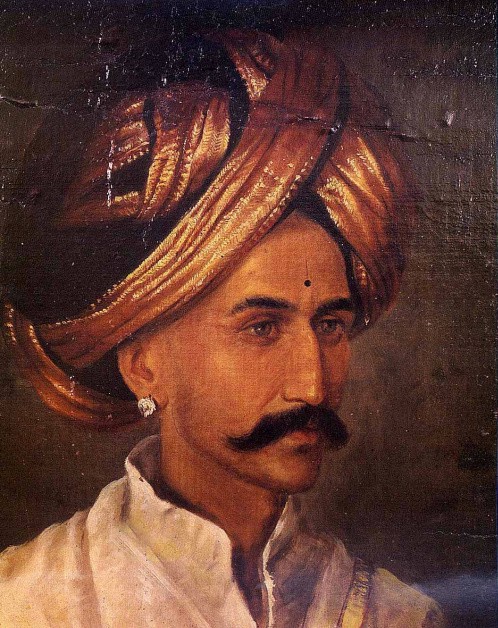
Apart from them there were other composers like Veena Venkatagiriyappa,Veena Venkatasubbaiah , Veena Shamanna, Veena Subbanna, Bidaram Krishnappa , T Chowdayya, Veena Raja Rao, Belakavadi Srinivasa Iyengar and Veena Shivaramaiah. The last two are notable for having to have composed in all 72 raganga ragas.
By this time, it was the end of Royal Mysore but thankfully the vaggeyakara tradition has continued. N Channakeshvaiah and C Rangaiah, both disciples of Mysore Vasudevacharya composed many varnas, krtis, ragamalikas and tillanas. Sri D Subbaramaiah — and his disciples Smt Vasantha Madhavi and Sri Ramaratnam are both composers of their own merit. Ballari Sheshachar among the Ballari brothers also has many compositions to his credit.
Many current day performing artists hailing from Karnataka such as Nagamani Srinath, RN.Sreelatha and Padmacharan have composed many compositions. Other performers such as Tirumale Srinivas,R K Padmanabha and Nagavalli Nagaraj have set to music many haridasa and others songs. And Sri T K Govindarao, who has composed may of his own compositions as well as has set many haridasa compositions.
At this point we should also remember the Poet Pu Ti Na who was not a performing artist in the conventional sense but has composed many wonderful compositions in his musical plays such as Gokuka Nirgamana. Poet D V Gundappa also has suggested ragas to the poems in his work Antahpura geete, written about the various madanika sculptures in the Beluru temple. However, I am not sure if the complete melodic structure for the songs were suggested by him.
Thankfully, the trend is still continuing. Ashok Madhav, originally from Karnataka, and a long time Pittsburgh resident has composed several hundred compositions. Srikanth Murthy, from Karnataka, currently in UK has to his credit many compositions in Kannada, Tamizh, Samskrta and Sanketi languages. I am also very happy to say that with the encouragement of the artist community in the Bay Area, I have also had the fortune of composing about 40+ compositions, which include Varna, Swarajathi, Tillana, javali and ragamalikas.
When there are such great compositions of past masters, one may ask what’s the need for new compositions. In fact Sangeeta Kalanidhi Sri R K Srikanthan opined when there are hundreds of great compositions of the composers like Tyagaraja, which are not being sung, there was no need of new compositions as such. I am pretty sure many others would share that opinion too. However, I would like to counter that with this samskrta verse of Jagannath pathak.
कियद्वारं क्रौञ्चा इह न निहता व्याधविशिखैः
परं काव्यं रामायणमिदम् इहैक समुदितम् ।
स कर्ता कालोsसौ स च हृदयवान् सा च कविता
समेत्य द्द्योतन्ते यदि वलति वाणीविलसितम् ॥
Since the beginning of time
How many Krauncha birds have been felled by arrows?
But the Ramayana arose only once.
The concoction of time, a soulful poet and his words
With a touch of Vani’s grace
To brew the broth of heady poetry
(English translation by Suhas Mahesh)
What this verse tells about poetry is also true about a music compositions. We just don’t know when the right situations arise, along with the grace of Goddess Saraswathi. Just for a moment, consider what would have happened if Tyagaraja thought there were plenty of good compositions of Purandara Dasa, Ramadasa and Annamayya, and did not make any of his own! Think what would have happened if Balamuralikrishna and Lalgudi Jayaraman thought there were plenty of excellent compositions of the trinity and did not compose any of theirs! So it is all the more desirable to continue the quest for more and music.
I will conclude with a Kannada translation of the very Samskrta verse. I just replace the word KavitA with rachanA, to make it more generic.
ಕೊಂಚೆವಕ್ಕಿಗಳೆನಿತೊ ಸಿಲುಕಿವೆ ಬೇಡ ಹೊಡೆದಿಹ ಬಾಣಕೆ
ಮುಂಚೆ ರಾಮಾಯಣವು ಮಾತ್ರವು ಹುಟ್ಟಿತೊಂದೇ ಬಾರಿಗೆ
ಕೊಂಚ ಕಾಲವು ಒಳ್ಳೆ ಮನಸಿನ ಕವಿಯ ಪದಗಳ ಜೊತೆಯಲಿ
ಸಂಚುಮಾಡಲುಬೇಕು ಸರಸತಿಯೊಡನೆ ಸೊಬಗಿನ ರಚನೆಗೆ
I would like to thank the organizers for giving an opportunity to share a few things with you all. ಎಂದರೋ ಮಹಾನುಭಾವುಲು ಅಂದರಿಕಿ ವಂದನಮುಲು. ನಮಸ್ಕಾರ
You can also listen to the speech ( with a few sections missing from the text) if you prefer to do so:












And also by including a book that I am reading/not finished, I hope it gives me motivation to finish all those unfinished books in my shelf, on my desk, on the Kindle, or on Google Play, VividLipi, NewsHunt and the PDFs of many gem of a books, sometime in my lifetime!
So here goes the last entry:
101; ಭಾರತೀಯಕಾವ್ಯಮೀಮಾಂಸೆ BharatiyaKavyaMimamse,by TeeNamShree- An excellent work on Indian Poetics.

Do you remember your history text books? I do. They were always a big bore, with random mentions of dates and events, never providing any insight about the historical times and the cultures. This was more so evident when it came to Indian history. The sections about Egypt and Roman civilizations seemed at least palatable compared to those about Indian civilization. I often asked myself why our history text books couldn’t be at least a bit interesting and insightful, and make the students inquisitive about our past.
So recently when I heard the text books for Karnataka state board were updated and available on the web, I was curious to see how the history books of today are, and if there was any improvement from my schooling days. To my horror, I found the updated high school texts very shoddily produced, full of factual, grammatical and typographic errors. I won’t bore you with all those – like those text books do – but will limit to one or two tidbits only. It suffices to state that if you open a random page, the probability of finding more than 3 errors (grammatical/ factual/ typographic) is almost 75%! And the probability of finding at least one error is very close to 100%. Very sad state of affairs in this time and age!
I started reading the 9th grade History text book. Just like you check one grain of rice to know if the entire pot is cooked or not, I will provide you with a sample ‘grain’ from this book. This short paragraph is about the new religious thinkers such as Mahavira and Gautama Buddha, their philosophical thoughts and the genesis of new cults/ religions (or whatever you want to call them).

According to this textbook, “new religions came in because there was a change in agriculture modes and what people ate. Buddhism and Jainism rose because eastern UP and Bihar came under new methods of agriculture not seen before, using iron ploughs. These ploughs needed oxen to pull them. There was a scarcity of oxen, because they were sacrificed in religious practices. Hence people were attracted to these new religions that opposed sacrifice of animals, and taught non-violence as a principle. This is why these religions became popular”.
I have read many a history book, but this was the first time I came across such an explanation. Of course, no citations for this conclusion are given in the book. The book is entirely devoid of any source citation. Neither does it make any distinction among fact, hypothesis, theory and inference. Everything is written as though it is crystal clear. I wonder what impression the teachers and students studying these ill-written text books will be getting about history in general, and of Indian history in particular.
When I shared the above section from the Karnataka text book on social media, I got a pointer from someone as to the source of such content in proof of its ‘supposed authenticity’ – A page from a book of 9th grade CBSE book written by R. S. Sharma. He is often cited as a source of reputable history by the secular circles in India.
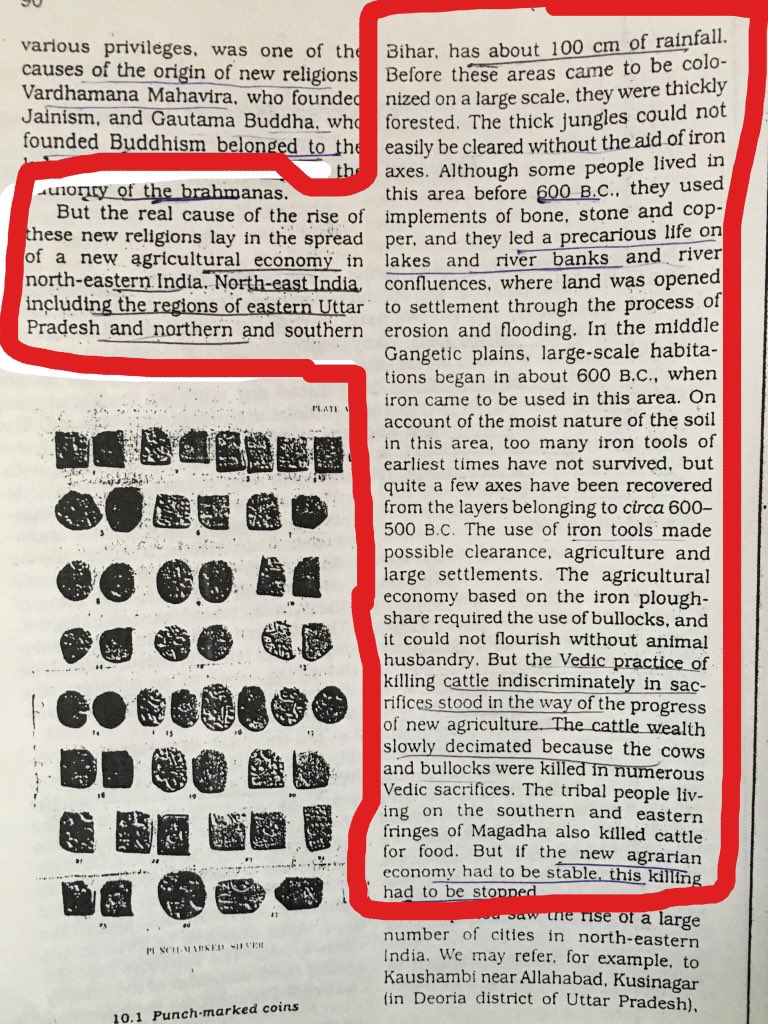
Now, since this was presented as an authentic source, I read through that page. It can be readily inferred that the Kannada text book draws material from this text. This book too does not say how such conclusions were drawn. So not much help there. This book of R. S. Sharma is prescribed as a text for 11th grade students. Incidentally looks like the same book is being used from times long before I was in 11th grade! Nevertheless, I hoped there have been revisions in tune with current research. So I just thought of doing some additional fact checking, and took a random paragraph from the book – this one dealing with the coming of Aryans to India.
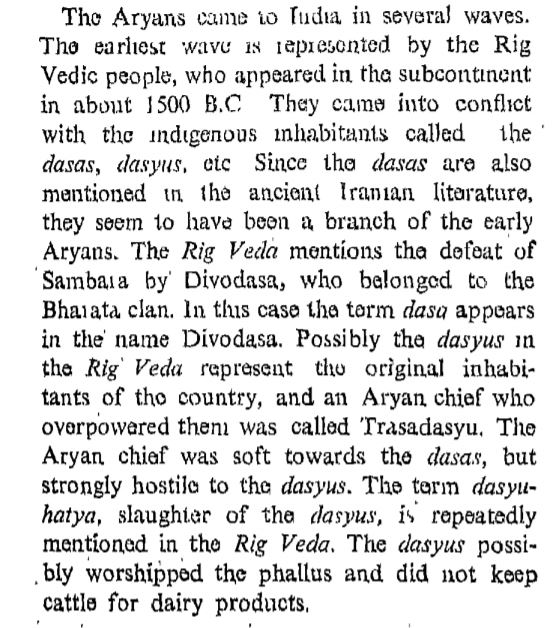
- Aryans came to India in several waves (May be true, may be not, but the text does not tell why or how that inference was made)
- Earliest wave was Rigvedic people who came to India around 1500 BC (Again, no indication how this date was arrived at, if there is any tangible proof etc)
- They came in contact with other tribes such as dasyus & dasas who were original inhabitants (Absolutely no evidence given about how/if these tribes were thought to be original inhabitants)
- They were a also a branch of ancient Iranians since their literature also mentions dAsa (This is the statement somewhat close to truth and supported by facts – that Rig Vedic people and ancient Iranians had something in common). But again if dasas were native Indians, did Iranians go from India (after Rig Vedic people came to India) ? The text remains mum about this.
- After stating “They (Rig Vedic Aryans) came into conflict with the indigenous inhabitants called the dasyus, dasas”, three sentences later the author says “Rig Veda mentions the defeat of Sambara by Divodasa, of the bharata clan” – Isn’t it logical Divodasa be a dasa?
- Now the author states “Possibly the dasyus in the Rig Veda represent the original inhabitants of the country, and an Aryan chief who overpowered them was called Trasadasyu’ – So within three lines another shift of the presentation! My only question to the author:“What were you smoking when you wrote this paragraph?”
- Next he says “The term dasyu-hatya, slaughter of the dasyus, is repeatedly mentioned in the Rig Veda.
When I saw the last bullet, I saw a good opportunity test it quantitatively. All the previous bullets were inferences, opinions, hearsay, and not quantitatively measurable. But talking about “repeated mention of a word or a phrase in a text” is a *very* measurable quantity.
Back when I was in high school there was no Internet, or no access to a Rig Vedic scholar. Or even if I had, I do not know if he knew the entire 1028 suktas (i.e. 10600 verses, 21200 lines to be very accurate), or if he would answer my questions about the Veda. Thankfully, now there is Internet, and the whole searchable Rig Veda is available at:
A search for the word ‘dasyu’ reveals that the word occurs exactly 51 times in all of the 21200 lines. Even assuming an average 5 words per line, this translates to 51 times in 106000 words. A whopping 480 parts per million! What an unbelievably high rate to be called a “repeated mention”!
Searching for the word ‘dasyu’ reveals that the word occurs exactly 51 times in all of the 21200 lines. Assuming an average 5 words per line, this translates to 51 times in 106000 words. A whopping 480 parts per million! What an unbelievably high rate to be called a “repeated mention”!
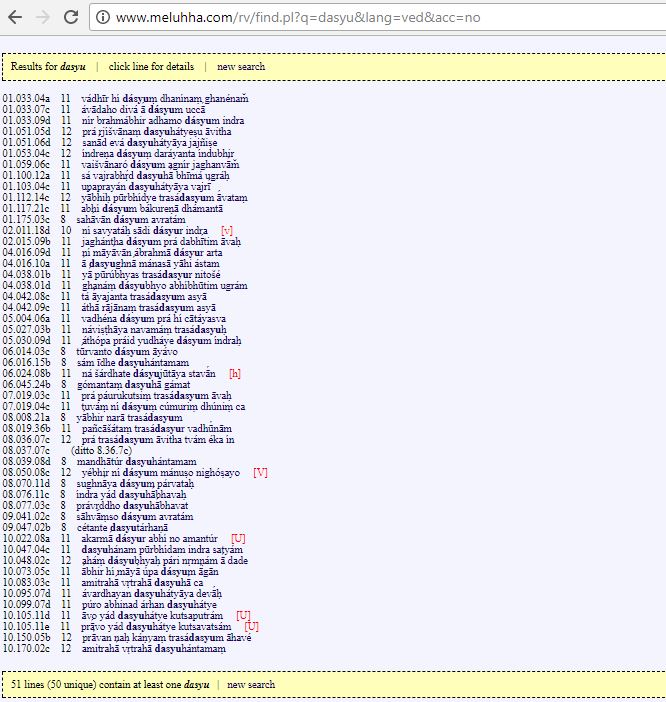
Oops. Sorry. Spoke too soon. What R. S. Sharma claims is that the phrase ‘dasyu-hatya’ is a frequent occurrence. Not the word dasyu. Let me look for it, for I want to stick with facts.
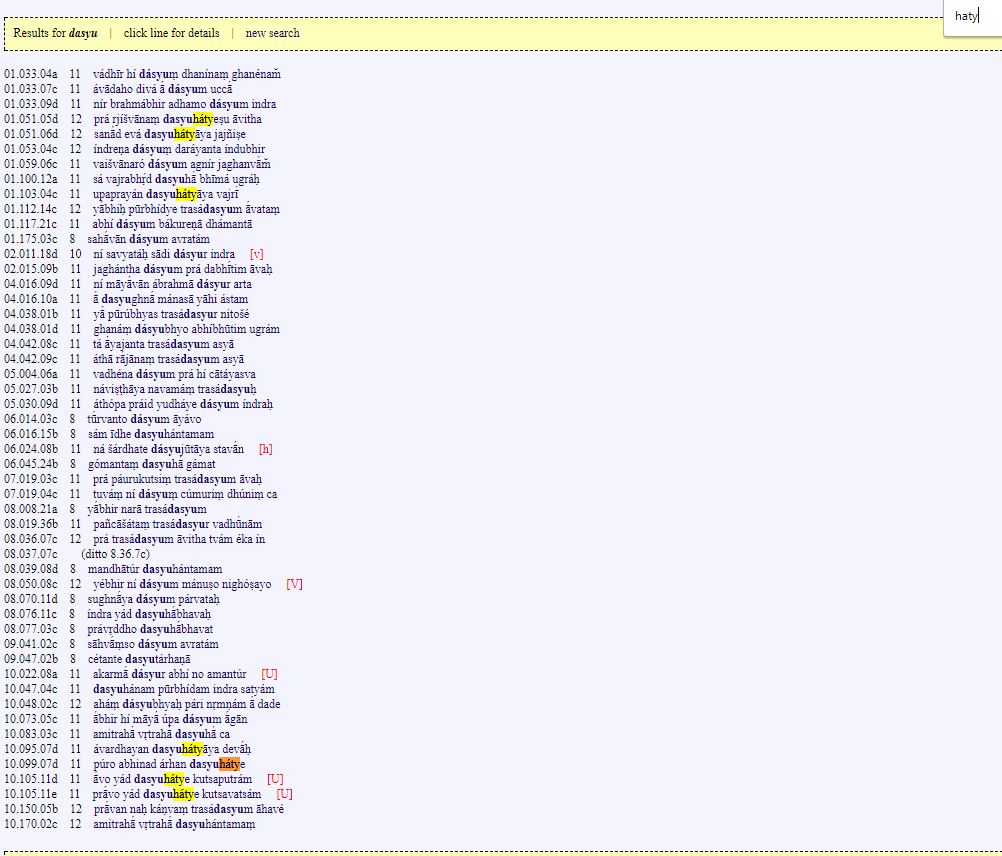
The term dasyu-hatya (or something related) occurs a total 7 times in the 21200 lines of Rig Veda. This translates to 66 parts per million. *VERY VERY HIGH OCCURRENCE*. Really!
Moral of the story: Text book writers may be under a rock for decades. We need not be. Not in today’s information age. This research was to be done by the text book writers. But surely they have not done it. If we care about the next generation of kids, I think we need to do our bit so that they don’t live under the rock forever.
-neelanjana



ಇತ್ತೀಚಿನ ಟಿಪ್ಪಣಿಗಳು